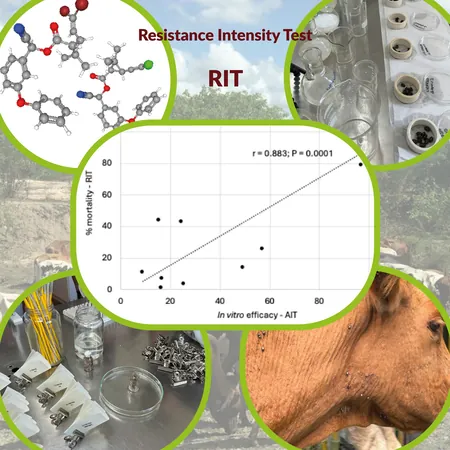
Unveiling A New Approach: The Resistance Intensity Test (RIT) for Acaricide Resistance in Cattle Ticks
2024-11-20
Author: Rajesh
Introduction
Acaricide resistance in livestock ticks, particularly the notorious Rhipicephalus microplus, poses a significant threat to cattle production, especially in tropical and subtropical regions like Brazil. Traditional methods such as the Adult Immersion Test (AIT) have been instrumental in identifying resistant populations, but their limitations often leave farmers in the dark about effective control strategies. Enter the Resistance Intensity Test (RIT), a groundbreaking larval-based bioassay that takes resistance detection to a new level by quantifying the intensity of acaricide resistance and predicting field efficacy.
Background and Context
The impact of R. microplus ticks is staggering. This invasive species, prevalent in Asia, sub-Saharan Africa, and across South and Central America, is responsible for losses exceeding three billion US dollars annually in Brazil alone. Current control measures heavily rely on chemical acaricides; however, extensive use has led to the emergence of resistant tick populations, complicating management efforts for farmers.
In Brazil, six classes of acaricides are commonly used, among which resistance against six has been reported. This alarming situation demands innovative solutions, hence the introduction of the RIT in conjunction with traditional bioassays like the AIT.
Methodology
The RIT approach utilizes tick larvae derived from engorged female ticks sampled from cattle across six ranches in Rio Grande do Sul. Both AIT and RIT were conducted using popular acaricides including deltamethrin and a mix of cypermethrin, chlorpyrifos, and piperonyl butoxide. The RIT quantifies resistance levels by exposing larvae to a range of acaricide doses, following WHO guidelines, thereby providing crucial insights into resistance intensity—low, moderate, or high.
Results and Findings
The study revealed striking results. In the AIT, the efficacy of deltamethrin ranged from 8.74% to 25.38%, indicative of significant resistance. In contrast, the combination product showed an efficacy of 49.31% to 100%, with resistance levels among the larval progeny varying from fully susceptible to low and moderate. A notable Pearson correlation coefficient (r = 0.883) indicated a strong alignment between both tests, reinforcing the reliability of the findings.
Conclusion
The introduction of the RIT marks a significant advancement in the fight against acaricide resistance in cattle ticks. By providing a clear assessment of resistance levels, it equips farmers and veterinarians with essential data to make informed decisions about acaricide use. This could lead to more effective management strategies that safeguard livestock health and protect agricultural economies.
Future Implications
As the fight against tick resistance intensifies, it is crucial to further refine this methodology and validate its results through field studies. The goal is to establish robust linkages between laboratory findings and practical farm applications, allowing a more targeted approach to manage resistance. The RIT could serve as a pivotal tool in the ongoing battle against acaricide resistance, potentially transforming how farmers approach tick control in the near future.
In Summary: Why You Should Care?
With acaricide resistance leading to severe economic repercussions, understanding and effectively addressing this challenge is more critical than ever. The RIT could be the key to turning the tide in tick management, providing farmers with the tools they need to combat this ever-growing threat to livestock. Don't get left behind—stay informed and adapt your strategies to protect your cattle and your livelihood!
 Brasil (PT)
Brasil (PT)
 Canada (EN)
Canada (EN)
 Chile (ES)
Chile (ES)
 Česko (CS)
Česko (CS)
 대한민국 (KO)
대한민국 (KO)
 España (ES)
España (ES)
 France (FR)
France (FR)
 Hong Kong (EN)
Hong Kong (EN)
 Italia (IT)
Italia (IT)
 日本 (JA)
日本 (JA)
 Magyarország (HU)
Magyarország (HU)
 Norge (NO)
Norge (NO)
 Polska (PL)
Polska (PL)
 Schweiz (DE)
Schweiz (DE)
 Singapore (EN)
Singapore (EN)
 Sverige (SV)
Sverige (SV)
 Suomi (FI)
Suomi (FI)
 Türkiye (TR)
Türkiye (TR)
 الإمارات العربية المتحدة (AR)
الإمارات العربية المتحدة (AR)